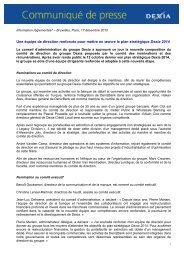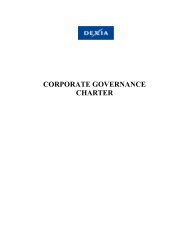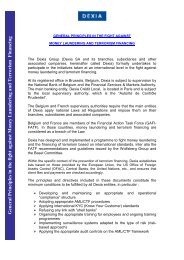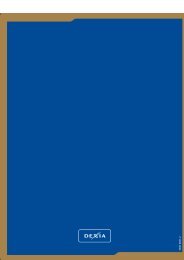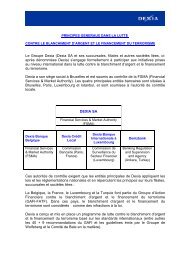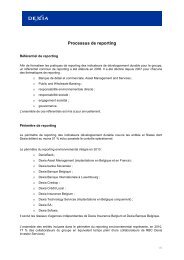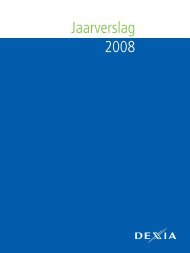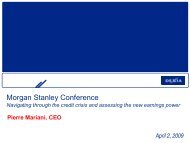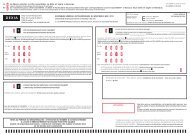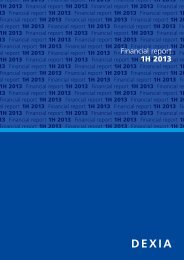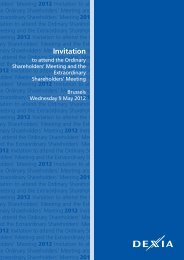Annual report 2010 - Dexia.com
Annual report 2010 - Dexia.com
Annual report 2010 - Dexia.com
- No tags were found...
Create successful ePaper yourself
Turn your PDF publications into a flip-book with our unique Google optimized e-Paper software.
Notes to the consolidated financial statementsthe hedged firm <strong>com</strong>mitment or forecast transaction affectsthe statement of in<strong>com</strong>e.1.13. HEDGE OF THE INTEREST-RATE RISKEXPOSURE OF A PORTFOLIOAs explained in 1.1.1 General, <strong>Dexia</strong> makes use of theprovisions in IAS 39 as adopted by the European Union (“IAS39 carve-out“) because it better reflects the way in which<strong>Dexia</strong> manages its financial instruments.Hedge accounting is intended to reduce the interest-rate riskexposure stemming from the selected category of assets orliabilities designated as the qualifying hedged items.<strong>Dexia</strong> performs a global analysis of interest-rate risk exposure.It consists in assessing fixed-rate exposure, taking intoaccount all the exposure <strong>com</strong>ing from balance sheet andoff-balance sheet items. This global analysis may excludecertain <strong>com</strong>ponents of the exposure, such as financial marketactivities, provided that the risk exposure stemming fromthe excluded activities is monitored on an activity-by-activitybasis.<strong>Dexia</strong> applies the same methodology to select which assetsand/or liabilities will be entered into the hedge of interestraterisk exposure of the portfolio. Assets and liabilities areincluded in all the time buckets of the portfolio. Hence, whenthey are removed from the portfolio, they must be removedfrom all the time buckets in which they had an impact.Demand deposits and savings accounts may be includedin the portfolio based on behavioural study for estimatingexpected maturity date. <strong>Dexia</strong> may designate as qualifyinghedged items different categories of assets or liabilities suchas available-for-sale assets or loan portfolios.On the basis of this gap analysis, which is realised on a netbasis, <strong>Dexia</strong> defines, at inception, the risk exposure to behedged, the length of the time-bucket, the test method andthe frequency of the tests.The hedging instruments are a portfolio of derivatives,which may contain offsetting positions. <strong>Dexia</strong> recognises thehedging items at fair value with adjustments accounted for inthe statement of in<strong>com</strong>e.<strong>Dexia</strong> <strong>report</strong>s hedged interest-rate risk revaluation of elementscarried at amortised cost on the balance sheet under the line“Fair value revaluation of portfolio hedges“.1.14. DAY ONE PROFIT OR LOSSThe day one profit or loss is applicable to all transactionsmeasured at fair value through profit or loss.The day one profit or loss is the difference between:• the transaction price and the quoted market price; in caseswhere the transaction is quoted; or• the transaction price and the fair value determined by usinga valuation technique, (mark-to-model) adjusted with somemarket value adjustments, such as a liquidity adjustment,model adjustment or credit adjustment in cases where thetransaction is not quoted.If <strong>Dexia</strong> considers the main parameters of the model asobservable and if Risk Management validates the model, theday one profit or loss will be recognised immediately in thestatement of in<strong>com</strong>e.If <strong>Dexia</strong> does not consider the main parameters as observableor if Risk Management does not validate the model, the dayone profit or loss will be amortised linearly over the expectedlife of the transaction. However, if the data be<strong>com</strong>esobservable subsequently, <strong>Dexia</strong> will recognise the remainingportion of day one profit or loss in the statement of in<strong>com</strong>e.In cases of early termination, the remaining portion of day oneprofit or loss will be recognised in the statement of in<strong>com</strong>e. Incases of partial early termination, <strong>Dexia</strong> will recognise in thestatement of in<strong>com</strong>e the part of the day one profit or lossrelating to the partial early termination.1.15. TANGIBLE FIXED ASSETSTangible fixed assets include property, plant & equipment andinvestment properties.All property, plant & equipment are stated at their cost lessaccumulated depreciation and impairments. Subsequent costsare, where necessary, included in the carrying amount of theasset or recognised as a separate <strong>com</strong>ponent, if it is probablethat future economic benefits will flow to the Group and thecost of the asset can be reliably measured.Depreciation is calculated using the straight-line method towrite down the cost of such assets to their residual valuesover their estimated useful lives.The main useful lives are as follows:• Buildings (including acquisition costs and non deductibletaxes): 20 to 50 years;• Computer equipment: 3 to 6 years;• Leasehold improvements, equipment and furniture: 2 to 12years;• Vehicles: 2 to 5 years.An item of property, plant & equipment can be <strong>com</strong>posed ofsignificant parts with individually varying useful lives. In sucha case, each part is depreciated separately over its estimateduseful life. The following parts have been defined:• Structure of the building: 50 years;• Roof, and frontage: 30 years;• Technical installations: 10 to 20 years;• Fixtures and fittings: 10 to 20 years.As borrowing costs that are directly attributable to theacquisition, construction or production of a qualifying assetform part of the cost of that asset they are capitalised. Otherborrowing costs are recognised as an expense.Tangible fixed assets are tested for impairment when anindication of impairment loss exists. Where the carryingamount of an asset is greater than its estimated recoverableamount, it is written down to its recoverable amount. Wherethe recoverable amount of an asset cannot be determinedindividually the Group determines the recoverable amount ofthe cash generating unit or group of cash generating unitsto which the asset belongs. Gains and losses on disposalsof property and equipment are determined by reference toManagement <strong>report</strong>Consolidatedfinancial statementsAdditional information <strong>Annual</strong> financial statements<strong>Annual</strong> <strong>report</strong> <strong>2010</strong> <strong>Dexia</strong>137



